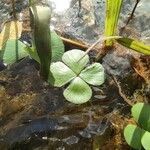Stipes slender, usually glabrous. Pinnae obdeltate to broadly obdeltate, usually glabrous, with brownish suberous streaks on under surface between veins of floating pinnae, flanks usually straight to convex, outer margin round, entire in floating ones, entire or sinuate or crenulate in aerial or subaerial pinnae. Pedicels terete, fairly stout, c. 3-7 mm long, erect or gently curved upwards, free or united to some extent with 2 or 3 others, usually inserted at very base of stipe. Sporocarps usually crowded (very rarely solitary), extremely variable in size, distally always rounded, elliptic in dorsiventral cross-section, without dorsal or frontal furrow or suture; lateral ribs usually invisible; teeth very prominent; sori 8-12.
A small fern. It grows in water or damp locations. It has creeping rhizomes. The fronds float. It has four leaflets. These are rounded or delta shaped and 1-2.5 cm long and wide. They are at the top of a slender leaf stalk. It only forms spore bodies in water.


